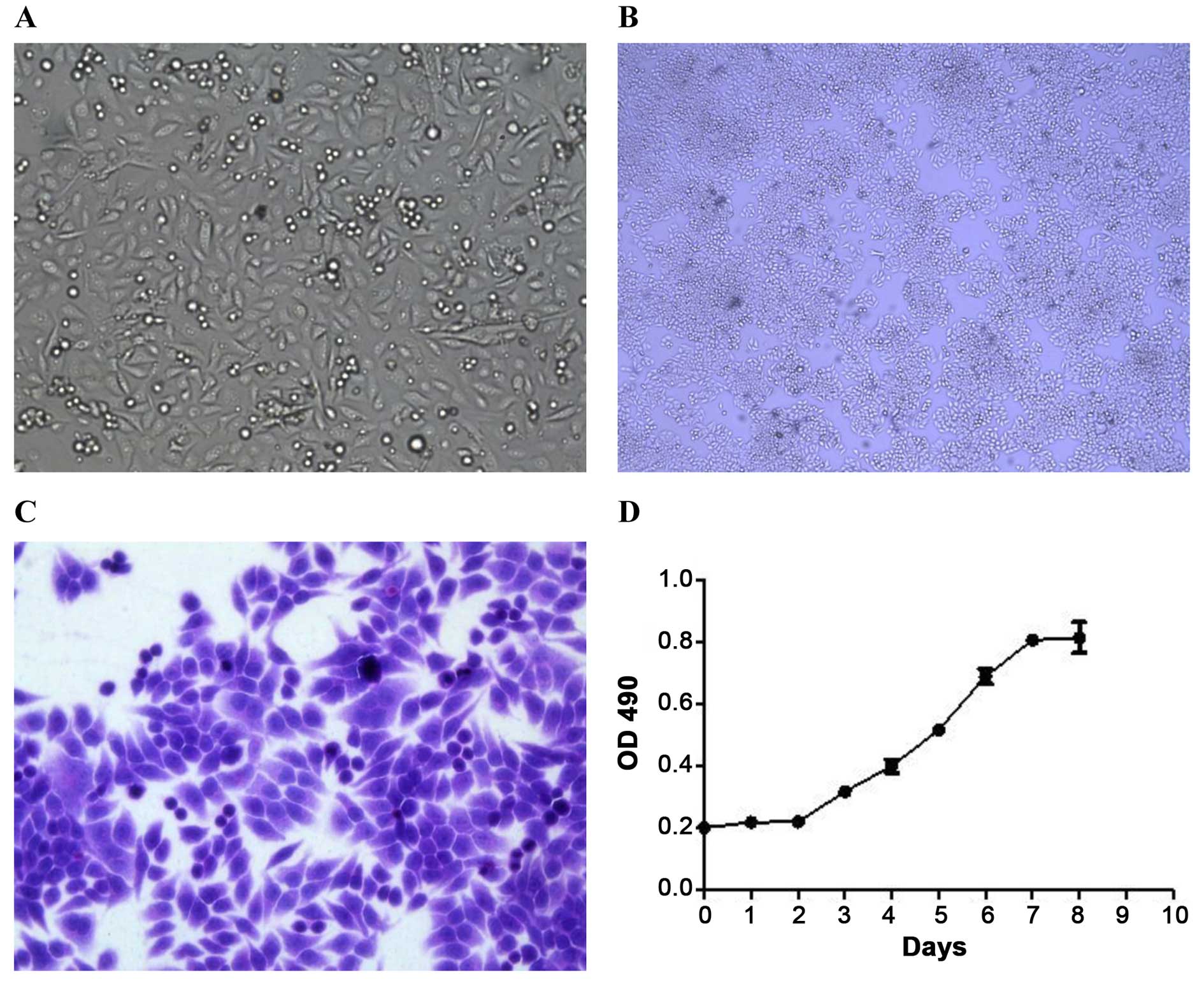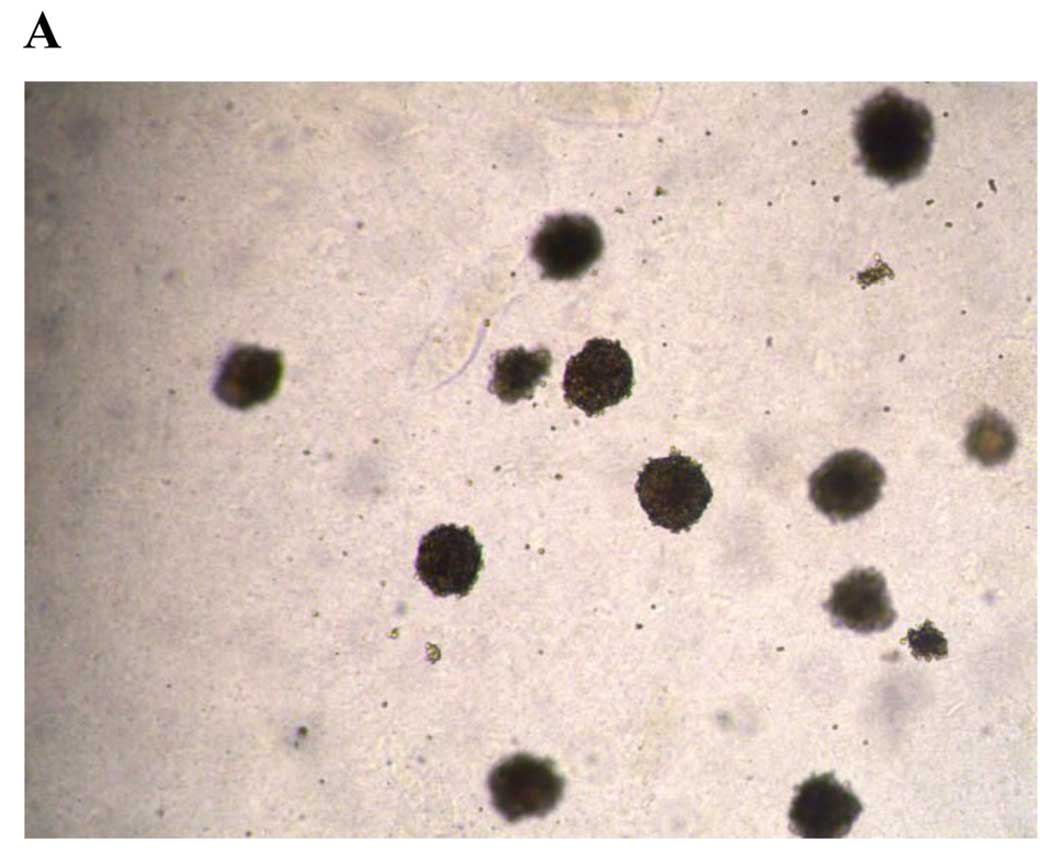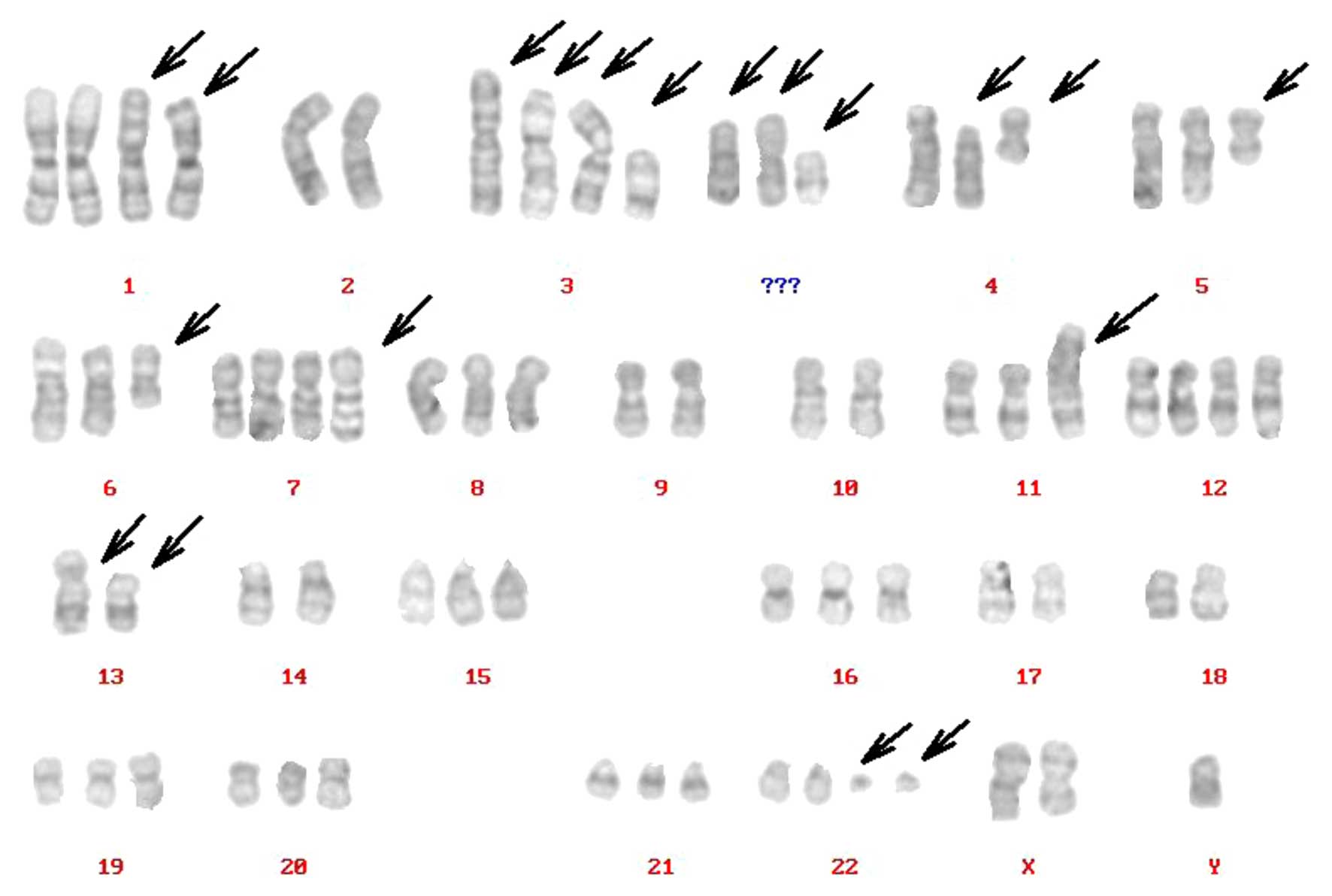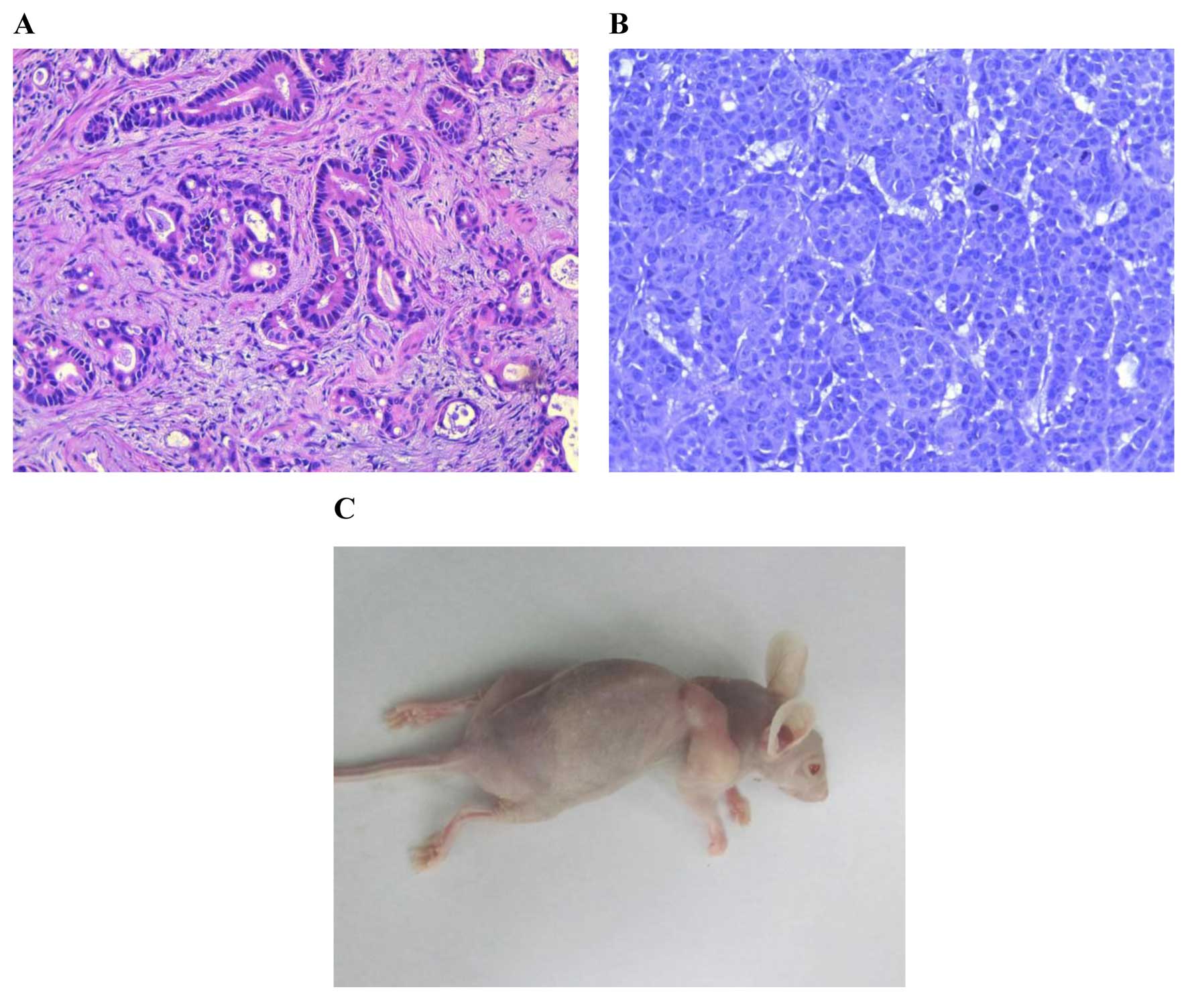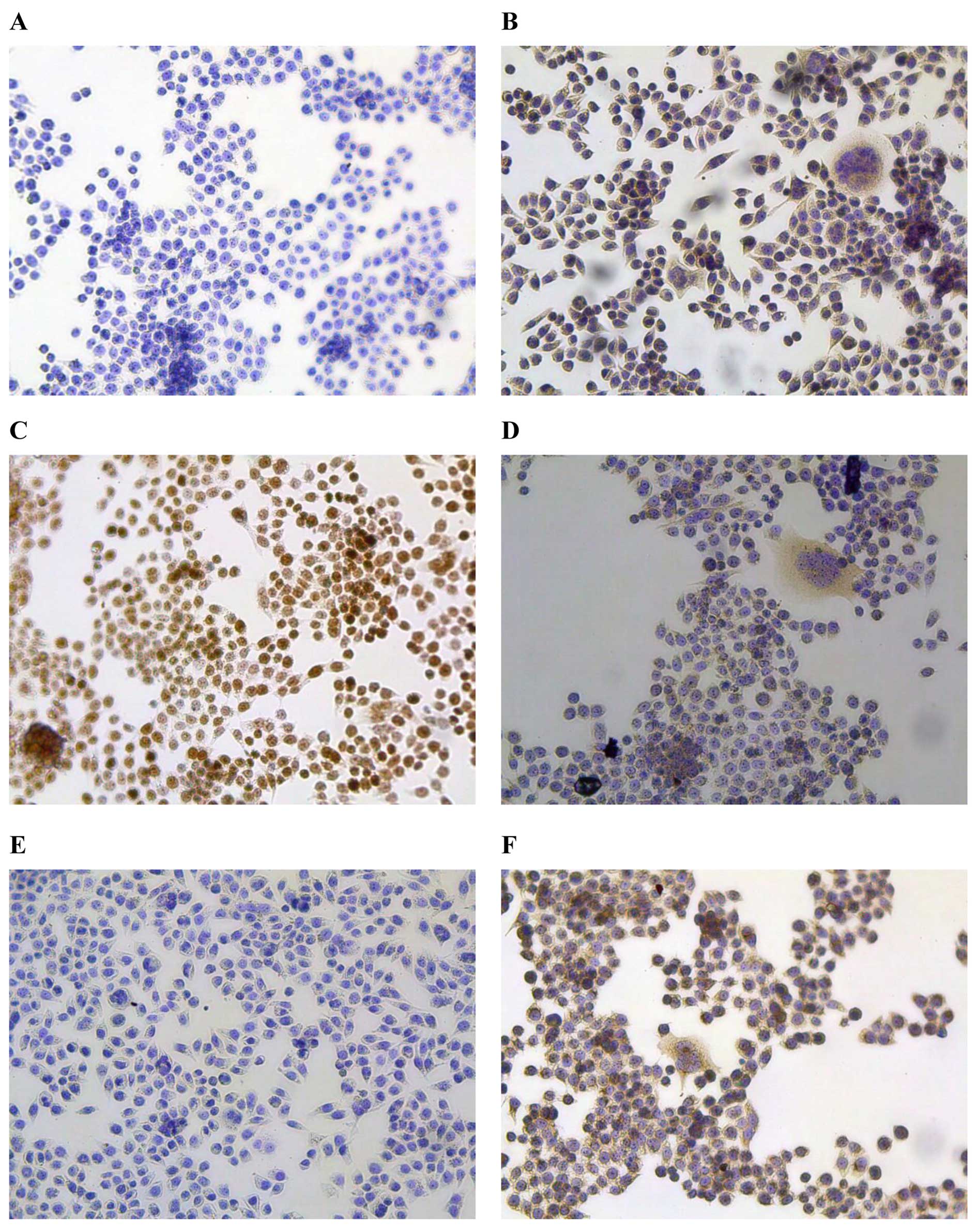Establishment and characterization of an expanding-type gastric cancer cell line by Ming's classification
- Authors:
- Published online on: September 14, 2016 https://doi.org/10.3892/or.2016.5090
- Pages: 3030-3036
Abstract
Introduction
Gastric cancer (GC) poses a significant health burden worldwide despite its declining incidence. GC is often diagnosed in advanced stages and has a poor prognosis. Globally, the incidence of GC ranks fourth for cancers in men and fifth in women, but its death rate is similar to that of lung cancer. Seventy percent of GC-related deaths occur in developing regions, with ~40% in China (1,2). The endemic regions are Asia, Eastern Europe and South America. The incidence of GC has declined over time due to improving living standards (3–5).
Based on our clinical experience, surgery continues to be the primary modality for managing early-stage GC; however, the survival rate of advanced GC is still poor since 80% of patients who underwent a curative resection develop locoregional or distant recurrence (6).
The first human cell line was established in a Baltimore laboratory over 50 years ago by Gey et al (7). Since then, numerous cancer cell lines have been established from human tumours; these cell lines have served as important experimental tools in oncology research. Currently, >30 GC cell lines are available (8–13) (Table I).
These cell lines have many advantages: they are very easy to handle, they are an infinite source of self-replicating cells, they have a relatively high degree of homogeneity, and they are easy to replace with frozen stocks if they become contaminated. However, these cell lines also have some shortcomings: cell lines easily have genotypic and phenotypic drift in culture; this drift is particularly frequent in the more commonly used cell lines, particularly those that have been deposited in Cell Banks for numerous years. Through specific mutations, various subpopulations that are fast growing or more malignant may arise as time goes on (14–16). Another important consideration for cell lines is cross-contamination or misidentification (17,18). The cell lines in current use are primarily derived from late-stage, poorly differentiated and metastatic tumours, particularly ascites or pleural effusions, which have accumulated the mutations required for indefinite growth in vitro (19); thus, the majority of these cell lines are aggressive and unrepresentative of the diverse tumour types, grades or stages as well as of the tumour progression indications that are observed in primary cancer. Thus, studies using these cell lines are biased towards more progressive and malignant cell lines or those established from late-stage disease. For these reasons, using cell lines that are derived directly from early-stage and well-differentiated primary tumours would be more meaningful, particularly since most drug therapies are directed against these types of tumours (15).
However, despite our growing understanding of this disease, the precise molecular and genetic steps for the oncogenesis of GC remain largely unknown; thus, there is a need to better understand the molecular pathogenesis of this disease. For this purpose, a well-characterized cell line may be an indispensable tool.
We report a new human expanding-type GC cell line, XGC-2, from a Chinese patient. This newly established cell line may be a useful model for the study of GC pathogenesis.
Materials and methods
Specimen collection
The specimens used in the present study were obtained with written informed consent from a 72-year-old Chinese male patient who underwent surgical resection at the First Affiliated Hospital of Xiamen University (Xiamen, China) for GC in the cardio-fundal junction of the stomach. The size of the original tumour was 6.5×4.5 cm. No distant metastasis was detected at the time of surgical resection. The tumour was histopathologically classified as a moderately differentiated gastric tubular adenocarcinoma.
The methods are parallel or identical to those employed by Wang et al as follows in the next six paragraphs (20).
Primary culture and establishment of the XGC-2 cell line
Tumour specimens were rinsed twice with sterile phosphate-buffered saline (PBS) containing antibiotics. The mucosa of tumour specimens was removed using a scalpel, and samples were then enzymatically disaggregated after incubation with collagenase type II and neutral protease solution at 37°C in a humidified atmosphere containing 5% CO2. After samples were incubated for ~0.5 h, small clusters of tumour cells were isolated, and 5 ml foetal calf serum (FBS) (Gibco, Grand Island, NY, USA) was added to terminate the digestion. Then, the digested tumour fragments and fluid were filtered through a 200 mesh sieve, and the filtrate was centrifuged at 1,000 rpm for 5 min. The supernatant was removed, and the remaining cells were resuspended in Dulbecco's modified Eagle's medium (DMEM) and Ham's F-12 medium (1:1) (Gibco) supplemented with penicillin (100 U/ml), streptomycin (100 µg/ml), heat-inactivated 2% FBS, hEGF (0.1 ng/ml), bFGF (0.1 ng/ml), hydrocortisone (25 µg/ml), fluconazole (40 µg/ml) (Gibco) and M-plasmocin (25 µg/ml) (Invitrogen); seeded into 12-well culture plates; and cultivated at 37°C in a humidified atmosphere of 5% CO2 in air. The growth medium was replaced every 2–3 days, and the plate was regularly checked for epithelial cells and fibroblast outgrowth. Whether fibroblast growth was observed during primary culture, a scraping method was used to obtain a pure tumour cell population. Twenty days after primary culture, the cells completely covered the bottom of the plate and were passaged, and the culture medium was changed to complete DMEM supplemented with 10% FBS, penicillin (100 U/ml) and streptomycin (100 µg/ml). Currently, the cell line has been cultured for >60 passages. The cells were tested for mycoplasma contamination, and the result was negative. The cell line was designated XGC-2 (Xiamen-gastric cancer).
Morphology of the XGC-2 cell line
Cells were directly imaged without staining under a phase contrast microscope.
Cell growth properties
Cells were plated in 96-well plates at 1,000 cells/well and cultured in DMEM containing 10% FBS for various durations. Cell numbers were measured by MTT assay, which was performed according to the manufacturer's protocol. The doubling times were determined from the growth curve.
Plating and colony-forming efficiency
Clone formation of different cell clones in soft agar was used to assess their growth capabilities. Cell suspensions were prepared in complete culture medium at low densities (1×104 cells/ml). These suspensions (0.1 ml) were seeded in a 12-well plate and incubated in a humidified 5% Co2 atmosphere at 37°C. Cultures were incubated for 14 days and regularly observed; colonies (≥10 cells) were counted by microscopic examination.
A single-cell suspension (1×104 cells/ml) was prepared. Agar (0.6%) was mixed with DMEM and added to 6-well plates as the lower layer. Then, 0.3% agar was mixed with the cell suspension, and the mixture was added to the same 6-well plate as the upper layer. Every well contained 1,000 cells. The plates were incubated at 37°C in a humidified incubator containing 5% Co2. Fourteen days later, cell colonies were counted under a microscope, and the clone formation rates were calculated using the following formula: Clone formation rate (%) = (number of colonies/number of cells inoculated) × 100%.
Chromosome analysis
Cells were karyotyped using a standard air-dried method after treatment with a final concentration of 0.05 mg/ml colcemid for 2 h when the cells were in the exponential growth phase. The cells were analysed using trypsin G banding. A total of 200 metaphase spreads were examined to determine the modal number. Karyotyping was performed according to the International System for Human Cytogenetic Nomenclature (2005). Chromosome analysis was carried out on the cell line at passage 45.
Tumourigenicity in nude mice
The study protocol for mice was approved by the Xiamen University Experimental Animal Care Commission. Briefly, cells at passage 30 were prepared to determine their tumourigenicity in nude mice. Cultured cells (2×107 cells/ml) were harvested, washed, resuspended in 0.1 ml complete DMEM, and subcutaneously injected into the right flanks of three 4-week-old female nude mice. The animals were examined every week for the development of tumours. Tumour-bearing mice were sacrificed. Tumour tissue was excised, fixed in 10% formalin and processed for routine histopathological examination.
Immunohistochemistry
Cell monolayers at passage 35 were subcultured and grown on sterile microscope slides. After confluent growth was obtained, the slides were washed with PBS, fixed in 4% paraformaldehyde for 15 min, air-dried and treated with 0.5% Triton X-100 for 20 min. PBS was used as the negative control, and the slides were then overlaid with the following antibodies: mouse monoclonal antibody directed against human cytokeratin, rabbit monoclonal antibody directed against Ki-67, mouse monoclonal antibody directed against human carcinoembryonic antigen, mouse monoclonal antibody directed against human E-cadherin, and mouse monoclonal antibody directed against human vimentin. Slides were incubated with antibodies for 60 min and thoroughly washed with PBS. A biotinylated rabbit anti-mouse IgG was subsequently applied for 15–20 min and samples were washed. Then, a solution of DAB was added to the slides, and the slides were incubated for 1–5 min at room temperature. Finally, the slides were rinsed with distilled water, counterstained with haematoxylin and eosin (H&E) and examined by light microscopy.
Statistical analysis
The statistical significance of differences between experimental groups and controls was determined by Student's t-test. Values of P≤0.05 were considered to indicate a statistically significant result.
Results
A new GC cell line, designated XGC-2, was successfully established in vitro with a fresh aseptic specimen derived from the primary tumour of a patient with GC. In this culture, we succeeded in freezing, thawing and subculturing cells for >60 generations in DMEM supplemented with 10% FBS.
In vitro characteristics of XGC-2 cells
The XGC-2 cell line grew as an adherent monolayer with characteristic epithelial morphology and showed no significant differences in successive culturing (Fig. 1A–C). The growth of the XGC-2 cell line was assayed by the MTT method. The XGC-2 cell line showed vigorous growth tendency and a doubling time of ~60 h (Fig. 1D).
Plating and colony-forming efficiency
To assess the anchorage-independent growth abilities of XGC-2 cells, plating and colony-forming assays were performed. XGC-2 cells showed strong anchorage-independent growth. A colony-forming efficiency of 45.8% was obtained when cells were plated at a concentration of 500 cells/well (Fig. 2A). Colonies were visible and densely packed 14 days after inoculation. The plating efficiency of XGC-2 cells after seeding at low cell densities was 8.13% (Fig. 2B).
Karyotype of the XGC-2 cell line
Complicated karyotypes were revealed in the XGC-2 cell line, which included gains, losses, translocations and other abnormalities, as determined by G-band analysis. The number of chromosomes ranged between 23 and 137; however, in 86% of the cells studied in the XGC-2 cell line, the chromosome counts were tightly clustered around the modal numbers and ranged only from 46 to 69 chromosomes/cell. The arrowheads indicate rearranged chromosomes. The representative karyotype was: 70,XY,del(X) (q22),der(1),+der(1),−2,der(3)t(3;4),der(3)t(3;5),der(3)t(3;13), del(3),del(4)(p10),i(4)(p10),i(5)(p10),del(6)(q21),+der(7)add(7) (q36),−9,−10,der(11),+12,der(13)add(13p),der(13),−14,−17,−18, 22ph, +mar1,+mar2,+mar3 (Fig. 3).
Histological examination
At 2 weeks after XGC-2 cells were subcutaneously injected into mice, tumours were found at the site of inoculation (Fig. 4C). The subcutaneous tumours were removed for histological examination and were compared with the original primary tumour. Both primary tumour (Fig. 4A) and subcutaneous tumours (Fig. 4B) were characterized by typical gastric tubular adenocarcinoma (H&E) features, and all were moderately differentiated.
Immunohistochemistry
As one of the main objectives in establishing human tumour lines is to use them to study tumour-specific marker(s), we evaluated this cell line for its capacity to express commonly used biomarkers. PBS was used as the negative control (Fig. 5A). The results of immunohistochemical staining revealed that CEA, a well-known biomarker for digestive system tumours, was positive in XGC-2 cells (Fig. 5B). Ki-67, a protein associated with active cell proliferation, was expressed at very high levels in the nucleus (≥80.6%), indicating the poor prognosis of the donor patient (Fig. 5C). Cytokeratin staining showed that the XGC-2 cells had an epithelial phenotype (Fig. 5D); however, E-cadherin, an epithelial marker, was downregulated in XGC-2 cells (Fig. 5E). Vimentin, the characteristic protein of mesenchymal cells, was expressed (Fig. 5F), suggesting that the XGC-2 cell had metastatic potential.
Discussion
In 1977, based on patterns of growth and invasiveness, Ming divided gastric carcinomas into two types: expanding and infiltrative. The 5-year survival rate of patients with expanding-type gastric cancer (GC) was 27.4%, while patients with infiltrative-type GC had a 5-year survival rate of only 9.9%. The two types have different biological behaviours and clinical prognosis. However, only a few studies on these types of GC have been performed due to the lack of appropriate cell lines. There have been no studies on the establishment of expanding- and infiltrative-type GC cell lines (21).
In the present study, a GC cell line (XGC-2) derived from a primary tumour that was shown to have characteristics of moderately differentiated adenocarcinoma by histological examination was established from a Chinese male patient. The XGC-2 cells grew as an adherent monolayer with characteristic epithelial morphology and had a population doubling time of ~60 h. Cultured cells showed comparable morphology to the primary culture following subculture passages. The XGC-2 cells were continuously grown for ~7 months, undergoing >60 passages, and growth continued even after recovery from cryopreservation. The XGC-2 cells also formed colonies in soft agar and plating assays. Furthermore, injection of the XGC-2 cells into nude mice resulted in tumour growth, and the histological features of the tumour resembled those of the original primary tumour. Immunohistochemistry revealed that XGC-2 cells were of epithelial origin, but the cells also showed vrious characteristics of mesenchymal cells, suggesting that the XGC-2 cells have metastatic potential.
Chromosomal aberrations including gains, losses, translocations and other abnormalities, are observed in almost all malignant tumours. To date, only a limited number of studies have investigated the cytogenetic changes in GC, and the molecular carcinogenesis of GC remains unclear (22–24). In the present study, we found that XGC-2 cells revealed common chromosomal alterations and a marked tendency to triploidy. However, the Y chromosome was detected in XGC-2 cells, in contrast to previous studies (25,26). The biological significance of the Y chromosome in tumour development is unknown, and further investigation is needed to elucidate the detailed mechanism.
Metastasis, the spread of tumour cells from the primary site through lymphatic and blood vessels or another route to distant sites followed by continued growth and formation of the same type of primary tumour, is a characteristic of malignant tumours and is the main cause of patients death. Many potential pathways and molecules are involved in the metastatic process (27). Epithelial-to-mesenchymal transition (EMT) is a key step towards cancer metastasis, which is characterized by the loss of epithelial cell markers of cell-cell adhesion molecules, such as E-cadherin (28,29). The expression of this protein is downregulated during the acquisition of metastatic potential at late stages of epithelial tumour progression (30). In the present study, E-cadherin expression was downregulated and vimentin expression was upregulated; however, the biological behaviours and clinical prognosis of expanding-type GCs are relatively better than those of infiltrative-type GCs, suggesting that the metastatic potential of the cells was due to not only the loss of E-cadherin, but also other factors that are crucial for metastatic processes, such as those that degrade and remodel the extracellular matrix and promote angiogenesis. The detailed mechanisms require further study.
In conclusion, we report the establishment and characterization of a new human expanding-type GC cell line derived from a primary tumour and termed XGC-2. Future studies of tumour biology, cellular and molecular carcinogenesis, and biomarkers for early diagnosis and drug responses to new therapeutic agents are needed for a better understanding of GC. This cell line should provide us with a new experimental model for future research of this disease.
Acknowledgments
The present study was supported by the national natural Science Foundation (nos. 81172283 and 81372616).
References
|
Wadhwa R, Song S, Lee JS, Yao Y, Wei Q and Ajani JA: Gastric cancer-molecular and clinical dimensions. Nat Rev Clin Oncol. 10:643–655. 2013. View Article : Google Scholar : PubMed/NCBI | |
|
Jemal A, Bray F, Center MM, Ferlay J, Ward E and Forman D: Global cancer statistics. CA Cancer J Clin. 61:69–90. 2011. View Article : Google Scholar : PubMed/NCBI | |
|
Bertuccio P, Chatenoud L, Levi F, Praud D, Ferlay J, Negri E, Malvezzi M and La Vecchia C: Recent patterns in gastric cancer: A global overview. Int J Cancer. 125:666–673. 2009. View Article : Google Scholar : PubMed/NCBI | |
|
Chen J, Bu XL, Wang QY, Hu PJ and Chen MH: Decreasing seroprevalence of Helicobacter pylori infection during 1993–2003 in Guangzhou, southern China. Helicobacter. 12:164–169. 2007. View Article : Google Scholar : PubMed/NCBI | |
|
Kawakami E, Machado RS, Ogata SK and Langner M: Decrease in prevalence of Helicobacter pylori infection during a 10-year period in Brazilian children. Arq Gastroenterol. 45:147–151. 2008. View Article : Google Scholar : PubMed/NCBI | |
|
Meyerhardt JA and Fuchs CS: Adjuvant therapy in gastric cancer: Can we prevent recurrences? Oncology. 17:714–733. 2003.PubMed/NCBI | |
|
Gey GO, Coffman WD and Kubicek MT: Tissue culture studies of the proliferative capacity of cervical carcinoma and normal epithelium. Cancer Res. 12:264–265. 1952. | |
|
Barranco SC, Townsend CM Jr, Casartelli C, Macik BG, Burger NL, Boerwinkle WR and Gourley WK: Establishment and characterization of an in vitro model system for human adenocarcinoma of the stomach. Cancer Res. 43:1703–1709. 1983.PubMed/NCBI | |
|
Motoyama T, Hojo H and Watanabe H: Comparison of seven cell lines derived from human gastric carcinomas. Acta Pathol Jpn. 36:65–83. 1986.PubMed/NCBI | |
|
Park JG, Frucht H, LaRocca RV, Bliss DP Jr, Kurita Y, Chen TR, Henslee JG, Trepel JB, Jensen RT, Johnson BE, et al: Characteristics of cell lines established from human gastric carcinoma. Cancer Res. 50:2773–2780. 1990.PubMed/NCBI | |
|
Park JG, Yang HK, Kim WH, Chung JK, Kang MS, Lee JH, Oh JH, Park HS, Yeo KS, Kang SH, et al: Establishment and characterization of human gastric carcinoma cell lines. Int J Cancer. 70:443–449. 1997. View Article : Google Scholar : PubMed/NCBI | |
|
Ku JL, Kim KH, Choi JS, Kim SH, Shin YK, Chang HJ, Bae JM, Kim YW, Lee JH, Yang HK, et al: Establishment and characterization of six human gastric carcinoma cell lines, including one naturally infected with Epstein-Barr virus. Cell Oncol. 35:127–136. 2012. View Article : Google Scholar | |
|
Akiyama S, Amo H, Watanabe T, Matsuyama M, Sakamoto J, Imaizumi M, Ichihashi H, Kondo T and Takagi H: Characteristics of three human gastric cancer cell lines, NU-GC-2, NU-GC-3 and NU-GC-4. Jpn J Surg. 18:438–446. 1988. View Article : Google Scholar : PubMed/NCBI | |
|
Holliday DL and Speirs V: Choosing the right cell line for breast cancer research. Breast Cancer Res. 13:2152011. View Article : Google Scholar : PubMed/NCBI | |
|
Burdall SE, Hanby AM, Lansdown MR and Speirs V: Breast cancer cell lines: Friend or foe? Breast Cancer Res. 5:89–95. 2003. View Article : Google Scholar : PubMed/NCBI | |
|
Osborne CK, Hobbs K and Trent JM: Biological differences among MCF-7 human breast cancer cell lines from different laboratories. Breast Cancer Res Treat. 9:111–121. 1987. View Article : Google Scholar : PubMed/NCBI | |
|
Capes-Davis A, Theodosopoulos G, Atkin I, Drexler HG, Kohara A, MacLeod RA, Masters JR, Nakamura Y, Reid YA, Reddel RR, et al: Check your cultures! A list of cross-contaminated or misidentified cell lines. Int J Cancer. 127:1–8. 2010. View Article : Google Scholar : PubMed/NCBI | |
|
Christgen M and Lehmann U: MDA-MB-435: The questionable use of a melanoma cell line as a model for human breast cancer is ongoing. Cancer Biol Ther. 6:1355–1357. 2007. View Article : Google Scholar : PubMed/NCBI | |
|
Cheung PF, Yip CW, Ng LW, Lo KW, Wong N, Choy KW, Chow C, Chan KF, Cheung TT, Poon RT, et al: Establishment and characterization of a novel primary hepatocellular carcinoma cell line with metastatic ability in vivo. Cancer Cell Int. 14:1032014. View Article : Google Scholar : PubMed/NCBI | |
|
Wang JH, Li LF, Yu Y, Li B, Jin HJ, Shen DH, Li J, Jiang XQ and Qian QJ: Establishment and characterization of a cell line, EH-GB2, derived from hepatic metastasis of gallbladder cancer. Oncol Rep. 27:775–782. 2012. | |
|
Ming SC: Gastric carcinoma. A pathobiological classification. Cancer. 39:2475–2485. 1977. View Article : Google Scholar : PubMed/NCBI | |
|
Ma S, Hu L, Huang XH, Cao LQ, Chan KW, Wang Q and Guan XY: Establishment and characterization of a human cholangiocarcinoma cell line. Oncol Rep. 18:1195–1200. 2007.PubMed/NCBI | |
|
Limpaiboon T, Tapdara S, Jearanaikoon P, Sripa B and Bhudhisawasdi V: Prognostic significance of microsatellite alterations at 1p36 in cholangiocarcinoma. World J Gastroenterol. 12:4377–4382. 2006. View Article : Google Scholar : PubMed/NCBI | |
|
Uhm KO, Park YN, Lee JY, Yoon DS and Park SH: Chromosomal imbalances in Korean intrahepatic cholangiocarcinoma by comparative genomic hybridization. Cancer Genet Cytogenet. 157:37–41. 2005. View Article : Google Scholar : PubMed/NCBI | |
|
Wada M, Yokota J, Mizoguchi H, Terada M and Sugimura T: Y chromosome abnormality in human stomach and lung cancerJpn. J Cancer Res. 78:780–783. 1987. | |
|
Yanagihara K, Seyama T, Tsumuraya M, Kamada N and Yokoro K: Establishment and characterization of human signet ring cell gastric carcinoma cell lines with amplification of the c-myc oncogene. Cancer Res. 51:381–386. 1991.PubMed/NCBI | |
|
Geiger TR and Peeper DS: Metastasis mechanisms. Biochim Biophys Acta. 1796:293–308. 2009.PubMed/NCBI | |
|
Boyer B, Vallés AM and Edme N: Induction and regulation of epithelial-mesenchymal transitions. Biochem Pharmacol. 60:1091–1099. 2000. View Article : Google Scholar : PubMed/NCBI | |
|
Kudo-Saito C, Shirako H, Takeuchi T and Kawakami Y: Cancer metastasis is accelerated through immunosuppression during Snail-induced EMT of cancer cells. Cancer Cell. 15:195–206. 2009. View Article : Google Scholar : PubMed/NCBI | |
|
Batlle E, Sancho E, Francí C, Domínguez D, Monfar M, Baulida J and García De Herreros A: The transcription factor snail is a repressor of E-cadherin gene expression in epithelial tumour cells. Nat Cell Biol. 2:84–89. 2000. View Article : Google Scholar : PubMed/NCBI |



